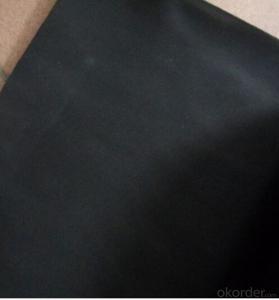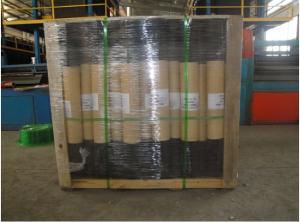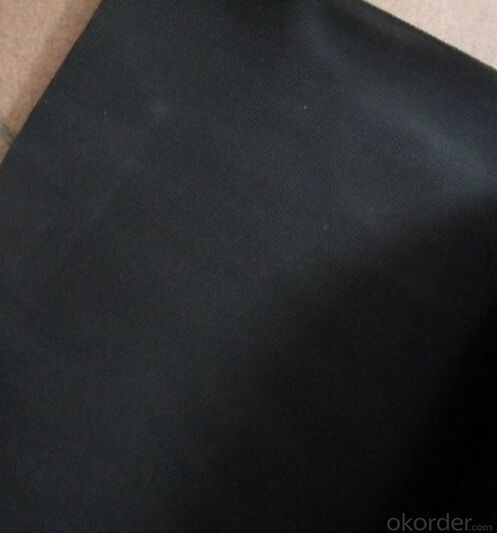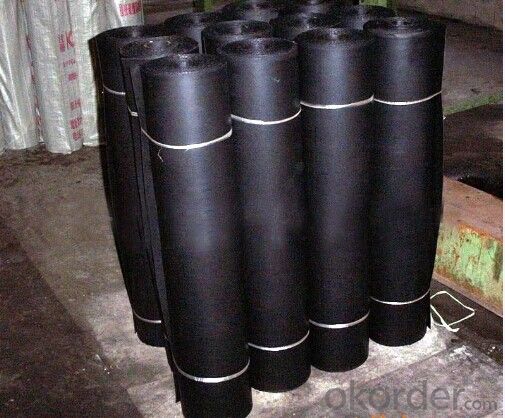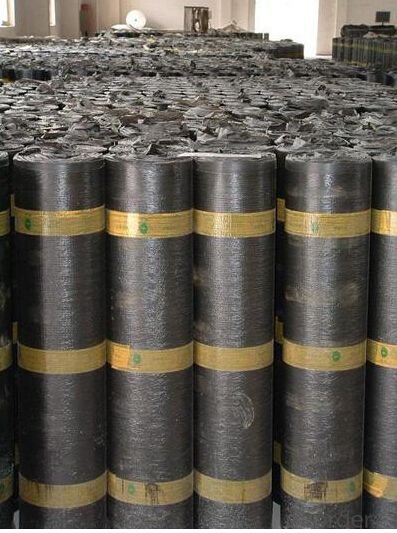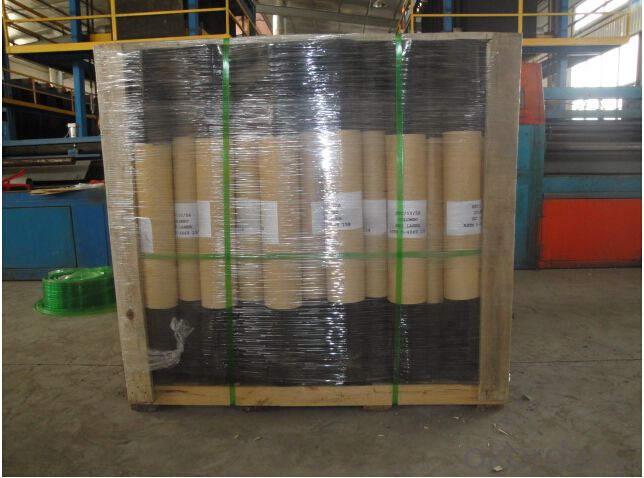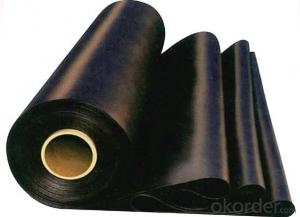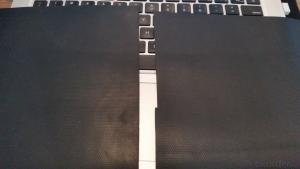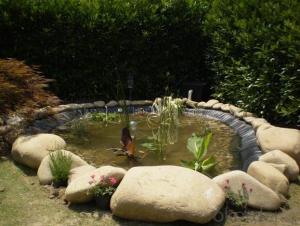EPDM Rubber Waterproof Membrane Used for Roof and Under Basement
- Loading Port:
- Qingdao
- Payment Terms:
- TT or LC
- Min Order Qty:
- 2000 m²
- Supply Capability:
- 200000 m²/month
OKorder Service Pledge
OKorder Financial Service
You Might Also Like
1. Product Feature for EPDM Waterproof Membrane:
a. UV resistant and anti-corrosion
b. High tensile strength and good elongation.
c. Easy installation, solid joint, and no environmental pollution
d. Good rooting penetration resistance
e. Service life up to 50 years
2. Product Specification for EPDM Waterproof Membrane:
There are two installation ways.one is full sticking,the other is hot welding.
Thick | 1.0mm,1.2mm,1.5mm,2.0mm,3.0mm or others |
Width | 1m to 4m |
Length | 20m |
Model | EPDM, EPDM with fabric |
3. Product Application:
1. Roofs, Basement, Toilet
2. Industrial and civil building waterproofing
3. Geosynthetic liner for swimming pool, channels, irrigation system
4. Especially suit for projects with high requirements in durability, anti-corrosion and deformation.
4. Some photos:
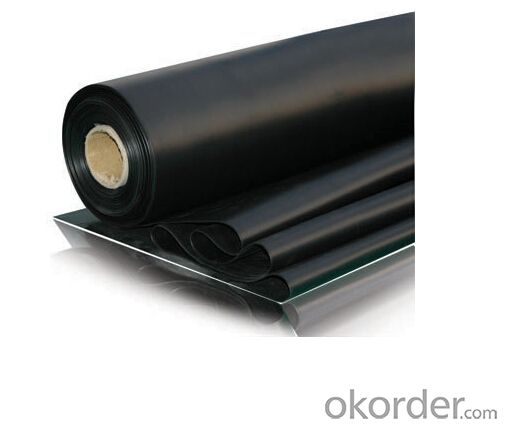

RFQ:
1) What's your package?
one roll with one woven bag, then 15-20rolls in one pallet
2) What's your payment terms?
T/T or L/C at sight
3) What's your delivery time?
Within one week against advance payment received
- Q: Can a waterproofing membrane be used on roofs with slope?
- Yes, a waterproofing membrane can be used on roofs with slope. In fact, it is commonly used on sloped roofs to provide an additional layer of protection against water intrusion. The membrane is typically installed beneath the roofing materials and acts as a barrier to prevent water from seeping into the roof structure. This is especially important on sloped roofs where water runoff is more rapid and can potentially result in leaks or damage. The waterproofing membrane is designed to be flexible and can accommodate the slope of the roof without compromising its effectiveness. Additionally, the membrane can also help to improve the overall durability and lifespan of the roof by preventing moisture-related issues such as rot or mold growth.
- Q: Can a waterproofing membrane be used in conjunction with insulation materials?
- Yes, a waterproofing membrane can be used in conjunction with insulation materials. In fact, it is often recommended to use both together in order to provide a comprehensive solution for protecting buildings from moisture and enhancing energy efficiency. The waterproofing membrane acts as a barrier to prevent water infiltration, while insulation materials help to regulate temperature and reduce heat loss or gain. By combining these two components, the building envelope can be effectively protected from water damage and insulated to maintain a comfortable indoor environment. It is important to ensure that the waterproofing membrane is properly installed and compatible with the insulation materials to achieve optimal performance and longevity.
- Q: How are waterproofing membranes installed?
- Waterproofing membranes are typically installed by first preparing the surface to ensure it is clean and free of any debris. Then, the membrane is unrolled and cut to size, ensuring it covers the entire area that needs to be waterproofed. Next, the membrane is adhered to the surface using a specialized adhesive or heat welding, depending on the type of membrane being used. Finally, any seams or joints are properly sealed to ensure a watertight installation.
- Q: Can a waterproofing membrane be used for seawalls or bulkheads?
- Yes, a waterproofing membrane can be used for seawalls or bulkheads. Waterproofing membranes are designed to provide a barrier against water penetration and can be applied to various structures, including seawalls and bulkheads. These membranes are typically made of materials such as bitumen, rubber, PVC, or polyurethane, which offer excellent resistance to water and ensure the structural integrity of the wall or bulkhead. The membrane is applied to the surface of the structure, forming a continuous and durable waterproof layer that prevents water from seeping through. This helps protect the seawall or bulkhead from erosion, corrosion, and other forms of damage caused by exposure to seawater. Additionally, waterproofing membranes can also provide additional benefits such as increased durability, improved aesthetics, and enhanced resistance to UV rays and chemicals. Overall, the use of a waterproofing membrane is an effective solution for ensuring the long-term performance and durability of seawalls and bulkheads in marine environments.
- Q: Can a waterproofing membrane be used in commercial buildings?
- Yes, a waterproofing membrane can be used in commercial buildings. It is commonly used as a protective barrier to prevent water infiltration in various areas such as basements, roofs, and foundations. The membrane acts as a reliable solution to ensure the longevity and structural integrity of commercial buildings, protecting them from potential water damage and leaks.
- Q: Can waterproofing membranes be applied on roofs?
- Yes, waterproofing membranes can be applied on roofs. In fact, they are commonly used in the construction industry to provide an extra layer of protection against water infiltration. These membranes are typically made of synthetic materials such as PVC, TPO, or EPDM, which are highly resistant to water and can effectively prevent leaks and water damage on roofs. The application of waterproofing membranes on roofs is a proven method to enhance the longevity and durability of the roofing system, especially in areas prone to heavy rainfall or extreme weather conditions. Additionally, waterproofing membranes are flexible and can be easily installed on various types of roofing materials, including concrete, metal, or asphalt shingles. Therefore, if you want to ensure a watertight roof and protect your property from water-related issues, using waterproofing membranes is a reliable and effective solution.
- Q: Can waterproofing membranes be used on expansion joints?
- Yes, waterproofing membranes can be used on expansion joints. Expansion joints are designed to accommodate movement and prevent damage caused by thermal expansion or contraction of building materials. Waterproofing membranes can be applied to expansion joints to create a barrier against water infiltration, which helps to maintain the structural integrity of the joint and prevent water damage to surrounding areas. It is important to select a waterproofing membrane that is flexible and able to withstand the movement of the joint without cracking or deteriorating. Additionally, proper installation techniques should be followed to ensure a watertight seal around the expansion joint.
- Q: Are waterproofing membranes resistant to chemical solvents?
- Yes, waterproofing membranes are generally resistant to chemical solvents. They are designed to provide a barrier against water and other liquids, including chemical solvents, to prevent leakage and damage to the underlying structure.
- Q: Can a waterproofing membrane be used in industrial facilities or warehouses?
- In industrial facilities or warehouses, it is possible to utilize a waterproofing membrane. These types of facilities typically have concrete floors or walls that are prone to water damage caused by leaks or moisture. By applying a waterproofing membrane, it becomes possible to shield these areas from water penetration, thereby preventing any potential harm to the structure and its contents. The purpose of waterproofing membranes is to establish a barrier that effectively prevents water from seeping through the surface, making them a practical solution for industrial facilities and warehouses where moisture control is of utmost importance. Furthermore, these membranes possess durability and can endure heavy foot traffic and equipment, making them ideal for use in areas with high levels of activity. Ultimately, the utilization of a waterproofing membrane in industrial facilities or warehouses plays a crucial role in maintaining a dry and secure environment, ensuring the protection of the structure and its contents.
- Q: Can a waterproofing membrane be used on precast cement board surfaces?
- Yes, a waterproofing membrane can be used on precast cement board surfaces. Precast cement board surfaces are commonly used in construction, especially for exterior applications. These surfaces are not inherently waterproof, so applying a waterproofing membrane can provide an extra layer of protection against water infiltration. A waterproofing membrane is a thin layer of material that is applied to the surface of the cement board. It forms a barrier that prevents water from penetrating the board and reaching the underlying structure. This is particularly important for areas that are exposed to moisture, such as bathrooms, kitchens, and outdoor installations. There are different types of waterproofing membranes available, including liquid-applied membranes and sheet membranes. Liquid-applied membranes are typically rolled or sprayed onto the surface, while sheet membranes are applied like a sticker. Both types provide an effective waterproofing solution for precast cement board surfaces. When choosing a waterproofing membrane for precast cement board surfaces, it is essential to consider the specific requirements and conditions of the project. Factors such as the level of water exposure, climate, and intended use of the surface should be taken into account. It is also important to follow the manufacturer's instructions for application, as proper installation is crucial for the effectiveness of the membrane. In conclusion, a waterproofing membrane can be used on precast cement board surfaces to provide additional protection against water infiltration. It is a wise choice for areas that are exposed to moisture and can help prolong the lifespan of the cement board and prevent damage to the underlying structure.
Send your message to us
EPDM Rubber Waterproof Membrane Used for Roof and Under Basement
- Loading Port:
- Qingdao
- Payment Terms:
- TT or LC
- Min Order Qty:
- 2000 m²
- Supply Capability:
- 200000 m²/month
OKorder Service Pledge
OKorder Financial Service
Similar products
Hot products
Hot Searches
Related keywords
